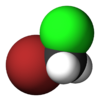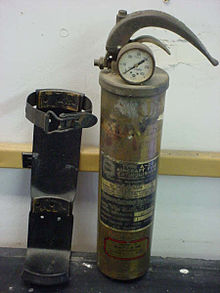- Bromochloromethane
-
Bromochloromethane 
 BromochloromethaneOther namesMonochloromonobromomethane, Bromo(chloro)methane, Chloromethyl bromide, Methylene chlorobromide, Methylene bromochloride, Borothene, Halon 1011, BCM, CBM, UN 1887
BromochloromethaneOther namesMonochloromonobromomethane, Bromo(chloro)methane, Chloromethyl bromide, Methylene chlorobromide, Methylene bromochloride, Borothene, Halon 1011, BCM, CBM, UN 1887Identifiers CAS number 74-97-5 
PubChem 6333 ChemSpider 6093 
EC number 200-826-3 KEGG C02661 
ChEBI CHEBI:17194 
ChEMBL CHEMBL346918 
RTECS number PA5250000 Jmol-3D images Image 1 - BrCCl
Properties Molecular formula CH2BrCl Molar mass 129.38 g/mol Appearance Colorless to yellow liquid with chloroform-like odor Density 1.9344 g/cm3 at 20 °C Melting point -86.5 °C
Boiling point 68.1 °C
Solubility in water 16.7 g/l Vapor pressure 15.6 kPa at 20 °C Hazards R-phrases R37, R38, R41, R59 S-phrases S26, S39, S59  (verify) (what is:
(verify) (what is:  /
/ ?)
?)
Except where noted otherwise, data are given for materials in their standard state (at 25 °C, 100 kPa)Infobox references Bromochloromethane or methylene bromochloride and Halon 1011 is a mixed halomethane. It is a heavy low-viscosity liquid with refractive index 1.4808.
It was invented for use in fire extinguishers by the Germans during the mid-40s, in an attempt to create a less-toxic, more effective alternative to carbon tetrachloride. This was a concern in aircraft and tanks as carbon tetrachloride produced highly toxic by-products when discharged onto a fire. CBM was slightly less toxic, and used up until the late 1960s, being officially banned by the NFPA for use in fire extinguishers in 1969, as safer and more effective agents such as halon 1211 and 1301 were developed. Due to its ozone depletion potential its production was banned from January 1, 2002, at the Eleventh Meeting of the Parties for the Montreal Protocol on Substances that Deplete the Ozone Layer.
It can be biologically decomposed using hydrolase enzyme alkylhalidase by the reaction:
In fiction
In the Enter the Matrix video game, the player can find a "Chloro-Bromo Methane Gun", which is used as a fire extinguisher. It fires a pressurized cartridge of CBM gas to put out fires. However, due to its chemical properties, firing a cartridge near people causes their lungs to fill with liquid, effectively drowning them.
External links
- International Chemical Safety Card 0392
- NIOSH Pocket Guide to Chemical Hazards 0123
- MSDS at Oxford University
- MSDS at Oxford University (deuterated bromochloromethane)
- Notice with Respect to n-Propyl Bromide and Bromochloromethane
- Chemical fact sheet
- Data sheet at arbemarle.com
Halomethanes Monosubstituted Disubstituted Trisubstituted Categories:- Halomethanes
- Fire suppression agents
- Ozone depletion
- Organobromides
- Organochlorides
Wikimedia Foundation. 2010.

